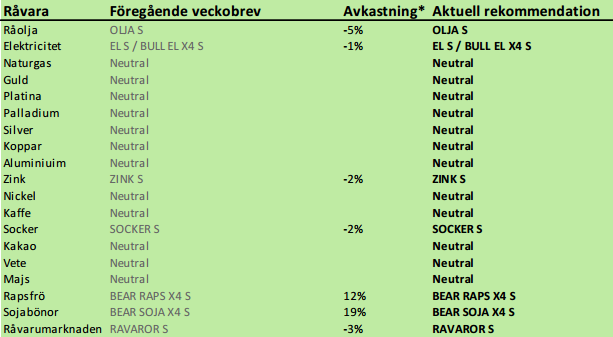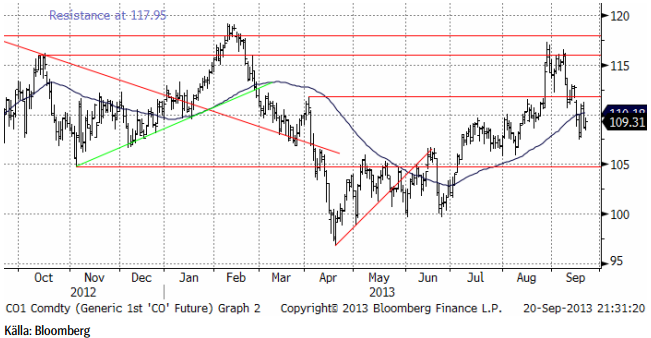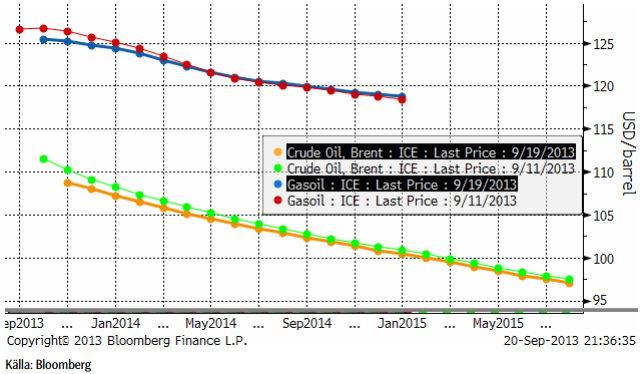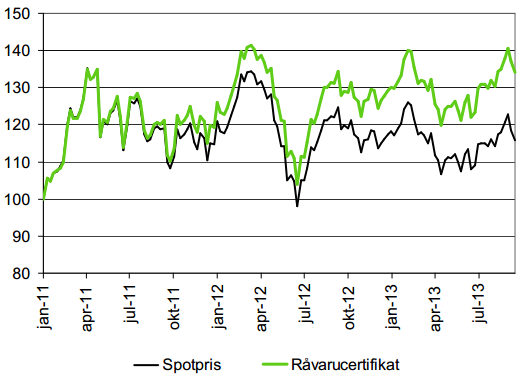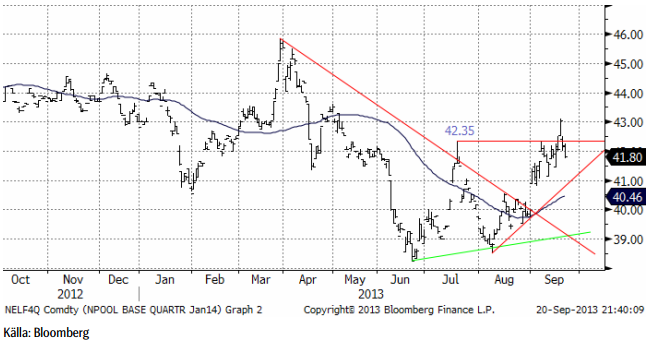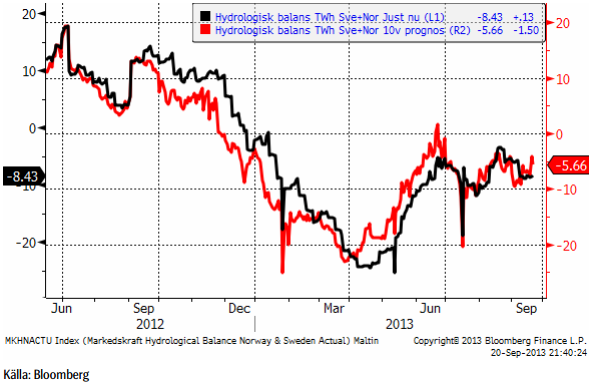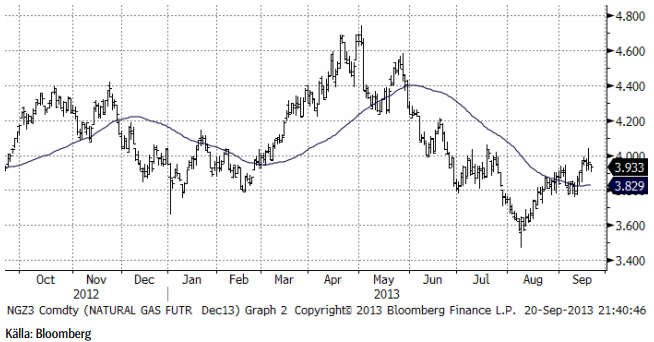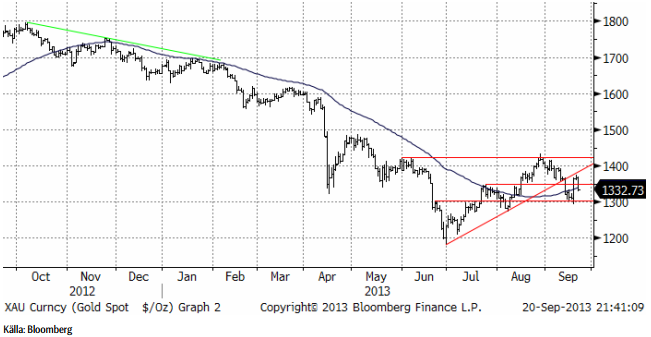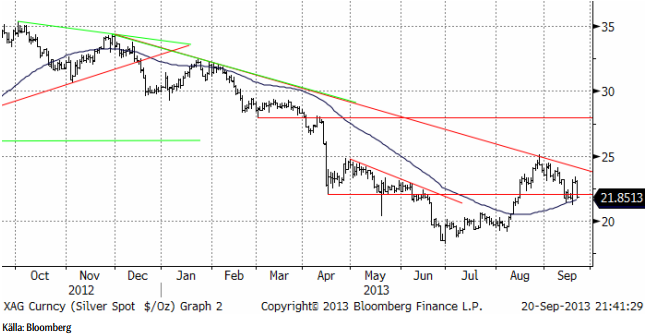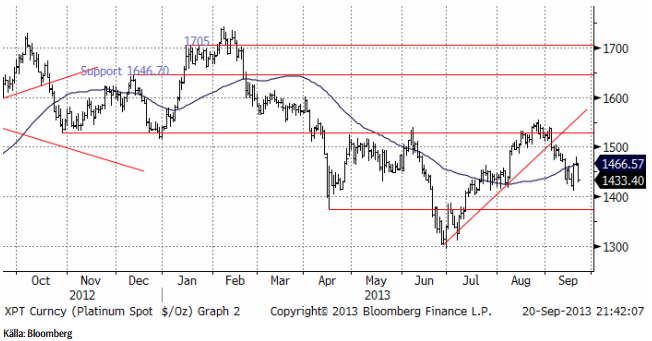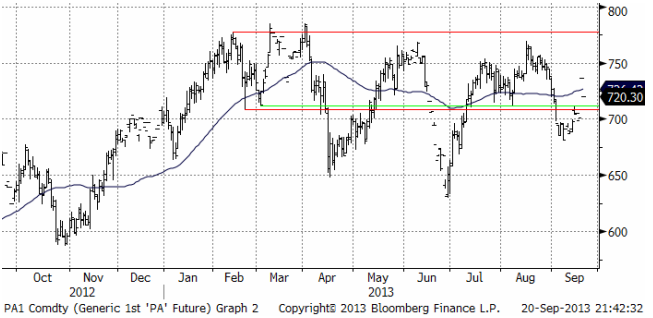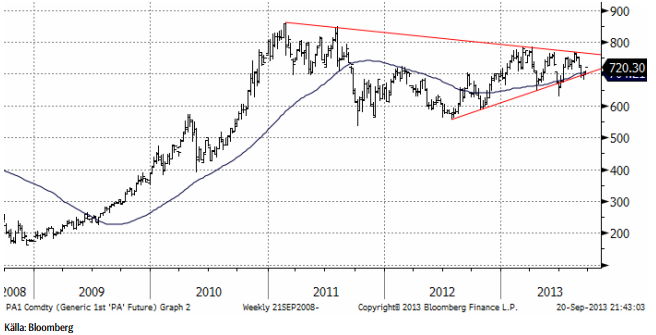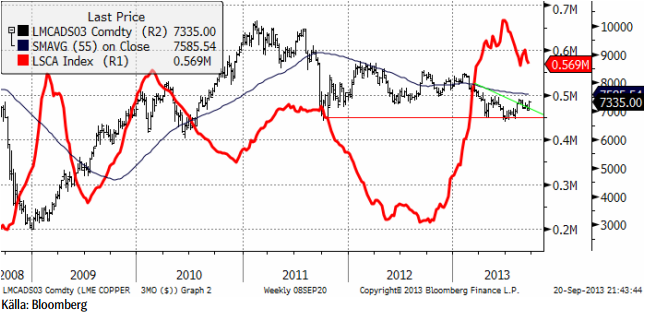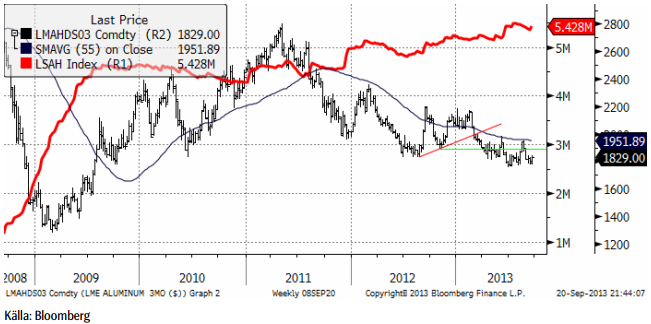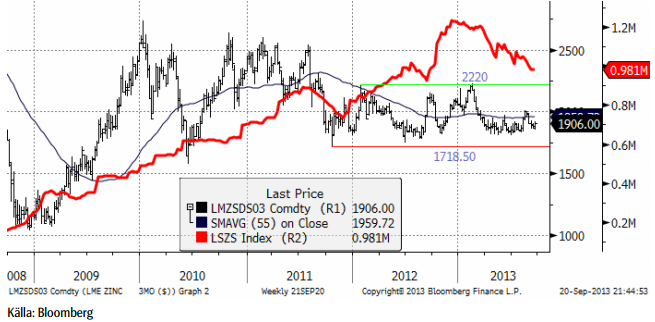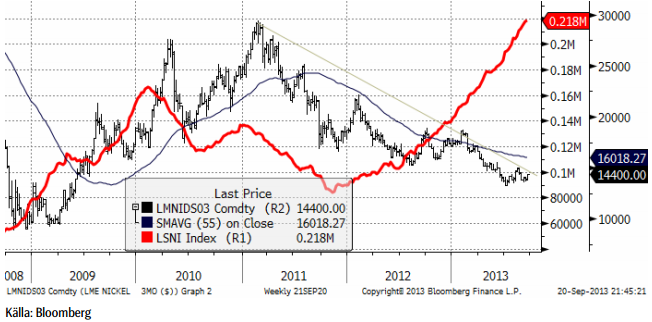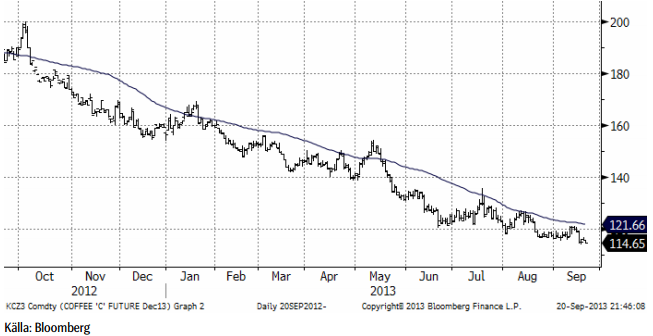Analys
SEB – Råvarukommentarer, 23 september 2013

Rekommendationer
*) Avkastningen anges för 1:1 certifikaten där både BULL och 1:1 certifikat är angivna.
Inledning
Prisrörelserna förra veckan påverkades mycket av den amerikanska centralbanken. Först kom beskedet att det inte blir någon minskning i centralbankens (FED:s) köp av amerikanska obligationer, förrän tidigast år 2015. Anledningen är att man inte sett tillräcklig effekt på ekonomin än av de köp (och utbetalningar av pengar) som skett. Man kan fråga sig var de läst att sedelpressen någonsin skapat sysselsättning. Beslutet fick alla råvarumarknader att hoppa upp. Råvarulandet Brasliens aktiebörs blev den bästa av nästan 100 aktiebörser i världen, den dagen. I fredags gjorde så en medlem i FED ett uttalande som antydde att det ändå kan bli fråga om minskning i centralbankens återköp. Analytiker tolkade detta som en del i FED:s kommunikationsstrategi. Marknaderna föll abrupt på detta sent på fredagen. Jag ser dock detta inte som en medveten kommunikationsstrategi utan som ett tecken på oenighet i FED om fortsatt pengaproduktion är rätt väg. Det viktiga är dock att de som tycker att sedelpressen ska stå på är i majoritet och att dissidenterna är få. Vid det senaste FED-beslutet var det endast en person som var emot en förlängning till 2015. Kanske har marknaden kommit fram till samma slutsats under helgen. I så fall skulle priserna kunna gå upp i veckan som kommer.
Inga tekniska stödnivåer bröts i under fredagens prisfall – utom för sojabönor – men ”it had it coming”. Vår position i BEAR SOJA X4 S ökade i pris med 19% i veckan. Vi är fortsatt negativa till sojabönor och raps, men neutrala till spannmål och vi har köp på socker, samt köp på el och zink. Generellt sett är det, som en kollega i branschen uttryckte det i fredags, ett gyllene läge för råvaror som placering.
I torsdags var vi på Copenhagen Grain Exchange, som besöktes av rekordmånga från branschen. När man talade med folk var den allmänna bedömningen att priset på spannmål kommer att hålla sig stabilt på den här nivån åtminstone fram till våren. Det är i sig ett observandum, att man tror att volatiliteten kommer att vara låg och att priserna kommer att vara låga. Det finns inget som tyder på det, men skulle det komma nyheter som indikerar högre priser, finns ingen psykologisk förberedelse på detta.
Råolja – Brent
Oljepriset fortsatte att rekylera nedåt och gick även igenom den psykologiskt viktiga 110-dollarsnivån. Vi tycker att detta gör olja än mer köpvärt. Det är rabatten på terminerna som gör att vi vill vara investerade i olja.
Terminskurvorna för Brent (den lägre) och gasolja (mer eller mindre detsamma som diesel) ligger något lägre jämfört med förra veckan. Men notera att medan terminskurvan för brent fallit för alla löptider, har kurvan för gasolja faktiskt vridit sig, så att de längre terminskontrakten ligger högre än förra veckan. Det är också väsentligt lägre grad av backwardation i gasoljekurvan än i oljekurvan. Man får bättre betalt för att vara investerad i olja än i gasolja.
Nedan ser vi hur 100 dollar i början av januari 2011 utvecklat sig om man investerat i fysisk råolja (svart linje) eller via terminer (grön linje). På grund av rabatten på terminerna, har mer än hälften av de ca 35% avkastning under dessa två år kommit från dem – och inte från prisförändring på fysisk råolja.
För råvaruinvesterare är den här rabatten nu väldigt attraktiv. Man kan tjäna ca 7 – 10% extra på att äga råoljeterminer.
När nu priset fallit tillbaka och rabatten på terminer är så attraktiv, tycker vi att det är ett bra tillfälle att komma in i den lönsamma oljemarknaden och rekommenderar köp av OLJA S. Det är framförallt rabatten på terminerna vi vill komma åt och därför föredrar vi OLJA S framför t ex BULL OLJA X4 S.
Elektricitet
Elpriset gick i veckan över motståndet på 42.35 och vi har nu en teknisk köpsignal på el. Vi skulle dock inte bli förvånade om det kom en rekyl nedåt, efter den snabba prisuppgång som varit. En sådan rekyl nedåt ser vi som ett utmärkt köptillfälle.
Hydrologisk balans visar inge större förändringar i veckan. 10-veckors-prognosen visar på ett marginellt mindre underskott än förra veckan.
Vi rekommenderar köp av el, t ex EL S eller BULL EL X4 S.
Naturgas
Naturgaspriset studsade var uppe vid 4 dollar, en nivå som tidigare varit ett motstånd.
Vi har neutral rekommendation.
Guld & Silver
Guldpriset fann stöd på 1300 dollar och rusade uppåt på FED-beskedet om fortsatt penningpolitisk stimulans åtminstone till år 2015. Detta vände till panikförsäljning i fredags när marknaden tolkade uttalandet från St. Louis-FED:s chef som att det nog ändå kunde bli frågan om en minskning av obligationsköpen innan 2015. Den tekniska bilden indikerar att lägre pris är att vänta, men vi har ingen säljsignal än, bara en bruten uppgång.
Nedan ser vi kursdiagrammet för silver i dollar per troy ounce. Tekniskt ser marknaden faktiskt lite mer positiv ut än guld. Den fallande trenden är dock inte bruten och vi skulle inte vilja köpa så länge detta inte har skett.
Vi fortsätter att vara neutrala guld och silver och skulle inte vilja köpa någon av dem idag.
Platina & Palladium
Prisuppgången i platina hindrades vid 55-dagars glidande medelvärde. Tekniskt ser platina svagare ut än både silver och guld. Det är många som hoppas på att platina och palladium ska gå bättre än guld och silver, därför att de också har ett industriellt invändningsområde i katalysatorer. Det innebär att det finns mycket förhoppningar investerat redan i metallerna och egentligen, en ganska stor nedsida.
Nedan ser vi frontmånadskontraktet på palladium. Palladium är en ganska illikvid metall och vi ser att priset steg kraftigt i veckan och sedan föll tillbaka.
Palladiumpriset är tillbaka i den triangelformation vi talat om tidigare.
Vi är för närvarande neutrala platina och palladium, men om palladium skulle falla bara något lite ytterligare, skulle vi vilja haka på och ta en kort position via BEAR PALLAD X4 S. Vi skulle absolut inte vilja köpa någon av dem.
Koppar
Koppar var den basmetall som gick bäst i veckan med en uppgång på 2.5%, trots den generella svagheten på fredagen. Tekniskt bröts den kortsiktiga nedåttrenden i torsdags. SEB:s tekniska analytiker gjorde följande bedömning på fredagen: “Rechecking $+7,400 before down… There is some near-term momentum in the ongoing move higher, as it was able to gap through short-term resistance at ≈7,200 (now likely support). This behavior puts the Aug high of 7,420 in focus, but extension beyond this level should be restricted to the 233day moving average band (7,445\7,575)”.
Den fysiska marknaden rapporteras vara i någorlunda balans. Arbitraget mellan SHFE och LME fanns förra veckan (Shanghai 200 dollar högre). Lagren på LME har fallit ytterligare 2.2% i veckan.
Det ser positivt ut, men uppsidan är begränsad, enligt den tekniska analysen. Vi fortsätter därför att ha en neutral position.
Aluminium
Aluminiumprisets relativa svaghet var tydlig i veckan. Vi rekommenderar att man försöker köpa BEAR ALU X4 S på rekyler (uppåt).
Den oberoende analysfirman Wood Mackenzie publicerade en rapport i veckan som gick, som utmålade en mörk framtid för aluminiummarknaden de kommande åren. De förutspår ett överskott nästa år på 1.1 mt. Det är en rejäl ökning av överproduktionen om man jämför med årets 0.5 mt. Kina behöver stänga produktion på 1.6 mt för att regionen ska komma i balans, enligt rapporten. Det råder samstämmighet bland bedömare att marknaden behöver stora produktionsneddragningar. Den här rapporten pekar på att detta kan ta längre tid än de flesta hoppats.
Vi har neutral rekommendation, men tycker man ska försöka komma in i BEAR ALU X4 S på rekyler uppåt.
Zink
Som vi har noterat tidigare, håller zink-balansen (utbud/efterfrågan) på att förbättras. ILZG rapporterade siffrorna för juli och de visade ett litet överskott. Produktionen av raffinerad zink var 1.109 mt i juli och efterfrågan var 1.095. Detta tog bort optimismen och gav baissarna ammunition. Men faktum är att trenden går mot ett underskott. Det tar naturligtvis tid att beta av de uppkomna lagren, men det ligger i priserna. De flesta som följer marknaden är överens om att gruvkapacitet kommer att stängas nästa år, och att ny kapacitet inte kommer att kompensera detta. Det finns en stor möjlighet till stora underskott framöver. Detta kommer att ge marknaden stöd enligt vårt sätt att se. Samtidigt verkar ekonomierna i Kina, USA och Europa ta fart och den effekten på underskottet måste också beaktas.
Zink blev en besvikelse den här veckan efter den oväntade svagheten i fredags och stängde ner 0.5% på veckan.
Vi fortsätter med en försiktig köprekommendation, av ZINK S.
Nickel
Nickel är traditionellt den mest volatila av metallerna som handlas på LME och den levde upp till sitt rykte den här veckan. FEDbeskedet fick priset att stiga från 13900 dollar till 14400. Detta vändes sedan i dramatiskt prisfall på fredagskvällen och veckan stängde bara precis över 14000 dollar. De stora och stigande lager hänger hotfullt över marknaden, men vi märker av mer intressen att köpa metallen från industrin. Med tanke på vad den tekniska analysen säger, tror vi det finns möjligheter för priset att nå 15000 dollar inom överskådlig tid. Nyhetsflödet kring Indonesiens export av järnmalm med nickelinnehåll för tillverkning av Nickel Pig Iron i Kina kommer att spela en central roll och vara en källa till volatilitet i marknaden.
Kaffe
Den fallande trenden i kaffepriset tog ett nytt trappsteg ner i veckan som gick. Den här nedgången är den längsta i tid sedan 1993.
Regn i Brasilien har fått kaffeträden att sätta blomknoppar för en andra blomning. Dessa blommor kommer sedan att bli bönor. Den kommande skörden är den växelvis större. Den skörd som just bärgats var ett mellanår. Arabica är en varannanårsgröda.
Brasilianska bönor av ”good cup” kvalitet (även kallad ”Swedish quality”, faktiskt) handlades till 18 till 21 cents rabatt till noteringen på ICE i New York. ”Fine cup” kvalitet handlas till en rabatt på 13 cent enligt företaget Flavour Coffee i Rio de Janeiro.
Flavour Coffee rapporterade också att Conillons, som den brasilianska robustan kallas, handlas till 8 cents premium över LIFFE:s terminspris i London, en uppgång från förra veckans premium på 5 cent. Det fanns även vissa kvaliteter av robusta som var dyrare än arabica. Robusta odlas mest i Afrika och i Asien, där Vietnam har blivit den största producenten. Robusta används mest i snabbkaffe.
Brasilien kommer att bärga en rekordskörd, av allt att döma och globala lager ökade med över 7% i augusti enligt tradinghuset FC Stone.
Vi behåller tills vidare neutral rekommendation, tills vi ser tecken på ett trendbrott.
Fler analyser på jordbruksråvaror från SEB.
[box]SEB Veckobrev Veckans råvarukommentar är producerat av SEB Merchant Banking och publiceras i samarbete och med tillstånd på Råvarumarknaden.se[/box]
Disclaimer
The information in this document has been compiled by SEB Merchant Banking, a division within Skandinaviska Enskilda Banken AB (publ) (“SEB”).
Opinions contained in this report represent the bank’s present opinion only and are subject to change without notice. All information contained in this report has been compiled in good faith from sources believed to be reliable. However, no representation or warranty, expressed or implied, is made with respect to the completeness or accuracy of its contents and the information is not to be relied upon as authoritative. Anyone considering taking actions based upon the content of this document is urged to base his or her investment decisions upon such investigations as he or she deems necessary. This document is being provided as information only, and no specific actions are being solicited as a result of it; to the extent permitted by law, no liability whatsoever is accepted for any direct or consequential loss arising from use of this document or its contents.
About SEB
SEB is a public company incorporated in Stockholm, Sweden, with limited liability. It is a participant at major Nordic and other European Regulated Markets and Multilateral Trading Facilities (as well as some non-European equivalent markets) for trading in financial instruments, such as markets operated by NASDAQ OMX, NYSE Euronext, London Stock Exchange, Deutsche Börse, Swiss Exchanges, Turquoise and Chi-X. SEB is authorized and regulated by Finansinspektionen in Sweden; it is authorized and subject to limited regulation by the Financial Services Authority for the conduct of designated investment business in the UK, and is subject to the provisions of relevant regulators in all other jurisdictions where SEB conducts operations. SEB Merchant Banking. All rights reserved.
Analys
Brent crude set to dip its feet into the high $50ies/b this week

Parts of the Brent crude curve dipping into the high $50ies/b. Brent crude fell 2.3% over the week to Friday. It closed the week at $61.29/b, a slight gain on the day, but also traded to a low of $60.14/b that same day and just barely avoided trading into the $50ies/b. This morning it is risk-on in equities which seems to help industrial metals a little higher. But no such luck for oil. It is down 0.8% at $60.8/b. This week looks set for Brent crude to dip its feet in the $50ies/b. The Brent 3mth contract actually traded into the high $50ies/b on Friday.

The front-end backwardation has been on a weakening foot and is now about to fully disappear. The lowest point of the crude oil curve has also moved steadily lower and lower and its discount to the 5yr contract is now $6.8/b. A solid contango. The Brent 3mth contract did actually dip into the $50ies/b intraday on Friday when it traded to a low point of $59.93/b.
More weakness to come as lots of oil at sea comes to ports. Mid-East OPEC countries have boosted exports along with lower post summer consumption and higher production. The result is highly visibly in oil at sea which increased by 17 mb to 1,311 mb over the week to Sunday. Up 185 mb since mid-August. On its way to discharge at a port somewhere over the coming month or two.
Don’t forget that the oil market path ahead is all down to OPEC+. Remember that what is playing out in the oil market now is all by design by OPEC+. The group has decided that the unwind of the voluntary cuts is what it wants to do. In a combination of meeting demand from consumers as well as taking back market share. But we need to remember that how this plays out going forward is all at the mercy of what OPEC+ decides to do. It will halt the unwinding at some point. It will revert to cuts instead of unwind at some point.
A few months with Brent at $55/b and 40-50 US shale oil rigs kicked out may be what is needed. We think OPEC+ needs to see the exit of another 40-50 drilling rigs in the US shale oil patches to set US shale oil production on a path to of a 1 mb/d year on year decline Dec-25 to Dec-26. We are not there yet. But a 2-3 months period with Brent crude averaging $55/b would probably do it.
Oil on water increased 17 mb over the week to Sunday while oil in transit increased by 23 mb. So less oil was standing still. More was moving.

Crude oil floating storage (stationary more than 7 days). Down 11 mb over week to Sunday

The lowest point of the Brent crude oil curve versus the 5yr contract. Weakest so far this year.

Crude oil 1mth to 3mth time-spreads. Dubai held out strongly through summer, but then that center of strength fell apart in late September and has been leading weakness in crude curves lower since then.

Analys
Crude oil soon coming to a port near you

Rebounding along with most markets. But concerns over solidity of Gaza peace may also contribute. Brent crude fell 0.8% yesterday to $61.91/b and its lowest close since May this year. This morning it is bouncing up 0.9% to $62.5/b along with a softer USD amid positive sentiment with both equities and industrial metals moving higher. Concerns that the peace in Gaza may be less solid than what one might hope for also yields some support to Brent. Bets on tech stocks are rebounding, defying fears of trade war. Money moving back into markets. Gold continues upwards its strong trend and a softer dollar helps it higher today as well.

US crude & products probably rose 5.6 mb last week (API) versus a normal seasonal decline of 2.4 mb. The US API last night partial and thus indicative data for US oil inventories. Their data indicates that US crude stocks rose 7.4 mb last week, gasoline stocks rose 3.0 mb while Distillate stocks fell 4.8 mb. Altogether an increase in commercial crude and product stocks of 5.6 mb. Commercial US crude and product stocks normally decline by 2.4 mb this time of year. So seasonally adjusted the US inventories rose 8 mb last week according to the indicative numbers by the API. That is a lot. Also, the counter seasonal trend of rising stocks versus normally declining stocks this time of year looks on a solid pace of continuation. If the API is correct then total US crude and product stocks would stand 41 mb higher than one year ago and 6 mb higher than the 2015-19 average. And if we combine this with our knowledge of a sharp increase in production and exports by OPEC(+) and a large increase in oil at sea, then the current trend in US oil inventories looks set to continue. So higher stocks and lower crude oil prices until OPEC(+) switch to cuts. Actual US oil inventory data today at 18:00 CET.
US commercial crude and product stocks rising to 1293 mb in week 41 if last nights indicative numbers from API are correct.

Crude oil soon coming to a port near you. OPEC has lifted production sharply higher this autumn. At the same time demand for oil in the Middle-East has fallen as we have moved out of summer heat and crude oil burn for power for air-conditioning. The Middle-East oil producers have thus been able to lift exports higher on both accounts. Crude oil and condensates on water has shot up by 177 mb since mid-August. This oil is now on its way to ports around the world. And when they arrive, it will likely help to lift stocks onshore higher. That is probably when we will lose the last bit of front-end backwardation the the crude oil curves. That will help to drive the front-month Brent crude oil price down to the $60/b line and revisit the high $50ies/b. Then the eyes will be all back on OPEC+ when they meet in early November and then again in early December.
Crude oil and condensates at sea have moved straight up by 177 mb since mid-August as OPEC(+) has produced more, consumed less and exported more.

Analys
The Mid-East anchor dragging crude oil lower

When it starts to move lower it moves rather quickly. Gaza, China, IEA. Brent crude is down 2.1% today to $62/b after having traded as high as $66.58/b last Thursday and above $70/b in late September. The sell-off follows the truce/peace in Gaze, a flareup in US-China trade and yet another bearish oil outlook from the IEA.

A lasting peace in Gaze could drive crude oil at sea to onshore stocks. A lasting peace in Gaza would probably calm down the Houthis and thus allow more normal shipments of crude oil to sail through the Suez Canal, the Red Sea and out through the Bab-el-Mandeb Strait. Crude oil at sea has risen from 48 mb in April to now 91 mb versus a pre-Covid normal of about 50-60 mb. The rise to 91 mb is probably the result of crude sailing around Africa to be shot to pieces by the Houthis. If sailings were to normalize through the Suez Canal, then it could free up some 40 mb in transit at sea moving onshore into stocks.
The US-China trade conflict is of course bearish for demand if it continues.
Bearish IEA yet again. Getting closer to 2026. Credibility rises. We expect OPEC to cut end of 2025. The bearish monthly report from the IEA is what it is, but the closer we get to 2026, the more likely the IEA is of being ball-park right in its outlook. In its monthly report today the IEA estimates that the need for crude oil from OPEC in 2026 will be 25.4 mb/d versus production by the group in September of 29.1 mb/d. The group thus needs to do some serious cutting at the end of 2025 if it wants to keep the market balanced and avoid inventories from skyrocketing. Given that IEA is correct that is. We do however expect OPEC to implement cuts to avoid a large increase in inventories in Q1-26. The group will probably revert to cuts either at its early December meeting when they discuss production for January or in early January when they discuss production for February. The oil price will likely head yet lower until the group reverts to cuts.
Dubai: The Mid-East anchor dragging crude oil lower. Surplus emerging in Mid-East pricing. Crude oil prices held surprisingly strong all through the summer. A sign and a key source of that strength came from the strength in the front-end backwardation of the Dubai crude oil curve. It held out strong from mid-June and all until late September with an average 1-3mth time-spread premium of $1.8/b from mid-June to end of September. The 1-3mth time-spreads for Brent and WTI however were in steady deterioration from late June while their flat prices probably were held up by the strength coming from the Persian Gulf. Then in late September the strength in the Dubai curve suddenly collapsed. Since the start of October it has been weaker than both the Brent and the WTI curves. The Dubai 1-3mth time-spread now only stands at $0.25/b. The Middle East is now exporting more as it is producing more and also consuming less following elevated summer crude burn for power (Aircon) etc.
The only bear-element missing is a sudden and solid rise in OECD stocks. The only thing that is missing for the bear-case everyone have been waiting for is a solid, visible rise in OECD stocks in general and US oil stocks specifically. So watch out for US API indications tomorrow and official US oil inventories on Thursday.
No sign of any kind of fire-sale of oil from Saudi Arabia yet. To what we can see, Saudi Arabia is not at all struggling to sell its oil. It only lowered its Official Selling Prices (OSPs) to Asia marginally for November. A surplus market + Saudi determination to sell its oil to the market would normally lead to a sharp lowering of Saudi OSPs to Asia. Not yet at least and not for November.
The 5yr contract close to fixed at $68/b. Of importance with respect to how far down oil can/will go. When the oil market moves into a surplus then the spot price starts to trade in a large discount to the 5yr contract. Typically $10-15/b below the 5yr contract on average in bear-years (2009, 2015, 2016, 2020). But the 5yr contract is usually pulled lower as well thus making this approach a moving target. But the 5yr contract price has now been rock solidly been pegged to $68/b since 2022. And in the 2022 bull-year (Brent spot average $99/b), the 5yr contract only went to $72/b on average. If we assume that the same goes for the downside and that 2026 is a bear-year then the 5yr goes to $64/b while the spot is trading at a $10-15/b discount to that. That would imply an average spot price next year of $49-54/b. But that is if OPEC doesn’t revert to cuts and instead keeps production flowing. We think OPEC(+) will trim/cut production as needed into 2026 to prevent a huge build-up in global oil stocks and a crash in prices. But for now we are still heading lower. Into the $50ies/b.
-

 Nyheter4 veckor sedan
Nyheter4 veckor sedanOPEC+ missar produktionsmål, stöder oljepriserna
-

 Nyheter2 veckor sedan
Nyheter2 veckor sedanGoldman Sachs höjer prognosen för guld, tror priset når 4900 USD
-

 Nyheter3 veckor sedan
Nyheter3 veckor sedanBlykalla och amerikanska Oklo inleder ett samarbete
-

 Nyheter3 veckor sedan
Nyheter3 veckor sedanGuld nära 4000 USD och silver 50 USD, därför kan de fortsätta stiga
-

 Analys4 veckor sedan
Analys4 veckor sedanAre Ukraine’s attacks on Russian energy infrastructure working?
-

 Nyheter2 veckor sedan
Nyheter2 veckor sedanLeading Edge Materials är på rätt plats i rätt tid
-

 Nyheter2 veckor sedan
Nyheter2 veckor sedanNytt prisrekord, guld stiger över 4000 USD
-

 Nyheter3 veckor sedan
Nyheter3 veckor sedanEtt samtal om guld, olja, koppar och stål


